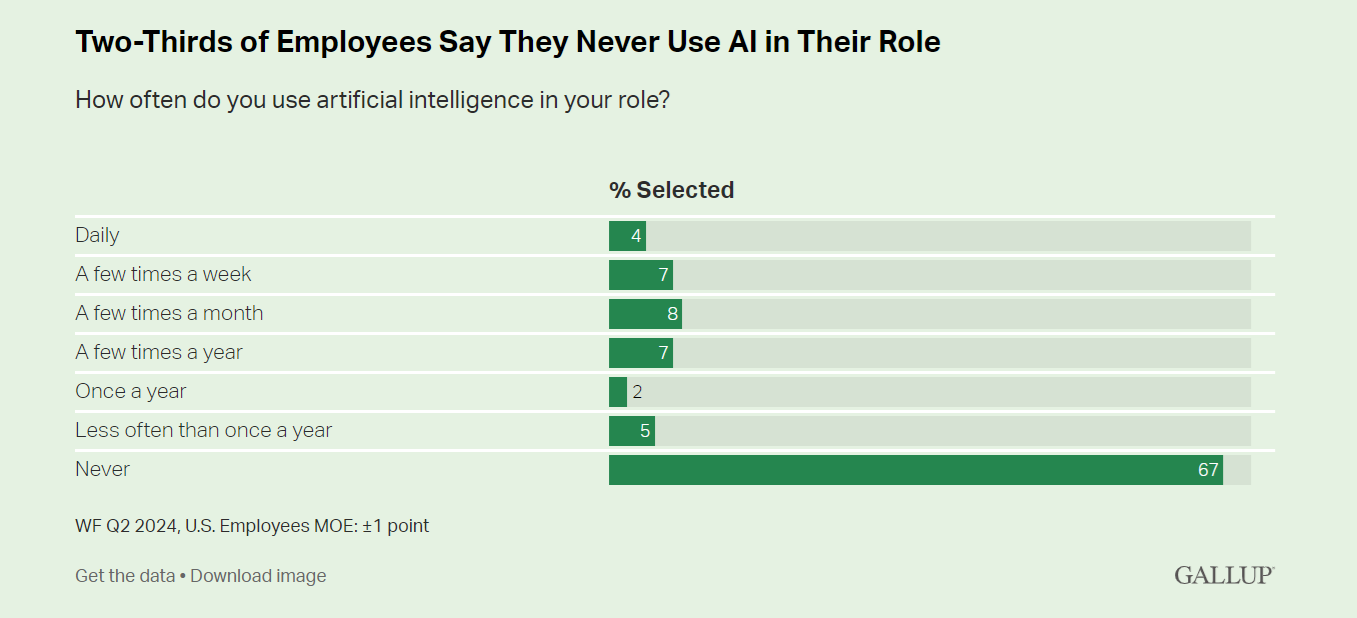AI is everywhere in conversations about the future of work. From boardrooms to breakrooms, few topics generate as much excitement, and anxiety, as artificial intelligence. Yet despite the hype, the day-to-day reality is sobering: most employees are not using AI at work.
Surveys show that two-thirds of employees never use AI at the workplace. Even among those who do, comfort levels remain low, with just 6% saying they feel very comfortable using it. Meanwhile, nearly one-third (32%) admit to outright discomfort.
This gap between potential and reality raises an urgent question: Why is AI in the workplace stalling, and what can leaders do to change the trend?
TL;DR
-
Most employees (66%) report they don’t use AI at work.
-
Comfort levels are low: only 6% very comfortable, 32% uncomfortable.
-
Adoption barriers include fear of job loss, limited access, weak leadership signals, and unclear applications.
-
AI at work has not meaningfully increased from 2023 to 2024.
-
Organizations need a people-first strategy combining training, leadership, and accessibility.
The State of AI at Work
The numbers tell a clear story about AI at work:
-
Usage gap: Two-thirds of employees don’t use AI in their jobs.
-
Comfort gap: Only 6% feel very comfortable with AI; 32% are uncomfortable.
-
Job security gap: A mere 6% of employees using AI say it has boosted their sense of job security.
In other words, while AI is advancing rapidly, employee adoption remains stuck in neutral.
Why Is AI at Work Stalling?
Several overlapping reasons explain why employees are not embracing AI in the workplace.
1. Fear of Job Loss
AI is often framed as a threat to employment. Many employees fear that using AI at work is akin to training their replacement. This cognitive dissonance drives some workers to avoid the technology altogether.
2. Lack of Access
In many organizations, AI tools are limited to leadership teams or specialized departments. Without access, the majority of employees simply cannot use AI in the workplace, regardless of interest.
3. Weak Leadership Signals
Organizational culture strongly influences adoption. When leaders don’t actively promote or model the use of AI at work, employees interpret this silence as a signal to ignore it.
4. Unclear Use Cases of AI at Work
AI feels abstract to many employees. Without specific examples of how AI fits into their day-to-day responsibilities, adoption stalls.
5. Training Gaps
Only a small fraction of employees report being confident in their ability to use AI effectively. Without role-specific training, AI in the workplace remains intimidating.
Why AI Adoption Hasn’t Changed Since 2023
Despite AI’s headline dominance, adoption at the employee level looks much the same in 2024 as it did in 2023.
The barriers: job fears, lack of access, limited leadership support, and inadequate training are still in place. While the technology has evolved, the human and organizational dynamics holding back adoption have not.
Does AI at Work Need a Fix?
Absolutely. Companies that fail to increase AI adoption at work risk losing ground to competitors that successfully leverage it for efficiency, insight, and innovation.
But the solution isn’t just about rolling out more tools. It’s about building a workplace culture that empowers employees to engage with AI.
How to Accelerate AI at Work
Here are strategies organizations can use to increase adoption:
1. Make Training Role-Specific
Generic AI overviews don’t resonate. Employees need tailored training that shows how AI applies directly to their roles. According to a Harvard Business Review analysis, adoption increases dramatically when companies invest in practical, role-based AI education rather than abstract strategy sessions.
Example: Instead of a broad “AI 101,” offer a workshop on how sales teams can use AI to analyze leads or how HR teams can automate routine screening tasks.
2. Address Job Security Concerns
Leaders must speak openly about how AI will (and won’t) impact employment. Framing AI as a collaborative assistant rather than a replacement tool helps build trust.
3. Lead by Example
When managers use AI in the workplace and share their experiences, it normalizes adoption. Leadership behavior sets the tone for company culture.
4. Provide Access to Tools
Adoption cannot happen if AI tools are locked away at the executive level. Employees need access to experiment and apply AI in their workflows.
5. Encourage Experimentation
Creating safe spaces for employees to try AI tools, without fear of mistakes, fosters comfort and sparks innovation.
Conclusion
AI at work is not stalled because of the technology itself, but because of human barriers: fear, lack of clarity, poor access, and weak leadership.
To move forward, organizations must empower employees through training, transparency, and access. By taking a people-first approach, businesses can ensure that AI in the workplace evolves from hype into practical, everyday advantage.
The future of work is about how people and AI collaborate.
FAQs
1. Why aren’t employees using AI at work?
Employees often fear job loss, lack access to tools, or don’t see how AI applies to their roles.
2. What can leaders do to increase its usage?
Leaders can provide training, model adoption, address fears about job security, and ensure tool accessibility.
3. Is AI adoption the same across industries?
No. Sectors like tech and finance are ahead, while manufacturing, healthcare, and public services are slower to adopt AI at work.
4. Can AI improve job satisfaction?
Yes, when used effectively, AI can free employees from repetitive tasks, allowing more focus on strategic or creative work.
5. What role does culture play in adoption of AI at work?
A supportive culture that encourages experimentation dramatically increases the likelihood of successful AI integration.
Related content you might also like:
- Work Is Changing: Can You Lead Machines as Well as People?
- HR Innovation: The Human Side of Tech for Leaders
- Can Technology Make Us Better Off While Also Taking Our Jobs?
- Sizing the Market Opportunity for Connected Wristwatches
- Automation has had a Ripple Effect on Gender Dynamics in the Workplace


